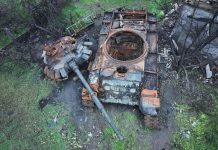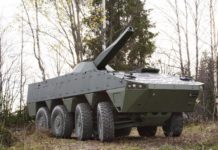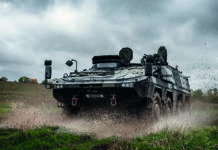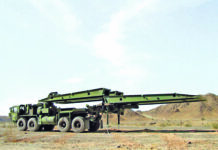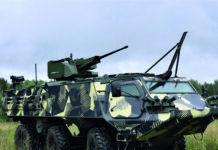Over the last 25 years, the United Kingdom has made numerous efforts to upgrade its ageing fleet of mainly tracked Armoured Fighting Vehicles (AFVs).
There have been numerous false starts including the Future Family of Light Armoured Vehicles, the joint UK/US TRACER (Tactical Reconnaissance Armoured Combat Equipment Requirement), BOXER Multi-Role Armoured Vehicle (MRAV) and the Future Rapid Effect System (FRES).
Today the situation has changed and the UK is now making major investments in its ground manoeuvre capability, with a mixture of upgrading older platforms including the CHALLENGER 2 main battle tank (MBT) and the WARRIOR infantry fighting vehicle (IFV) and the procurement of brand new platforms including the AJAX family of vehicles (FOV). As of result of the UK General Election held in December 2019 which resulted in a clear overall majority for the Conservative party, there will be another defence review which could potentially have an effect on some major UK programmes, including those for the British Army.
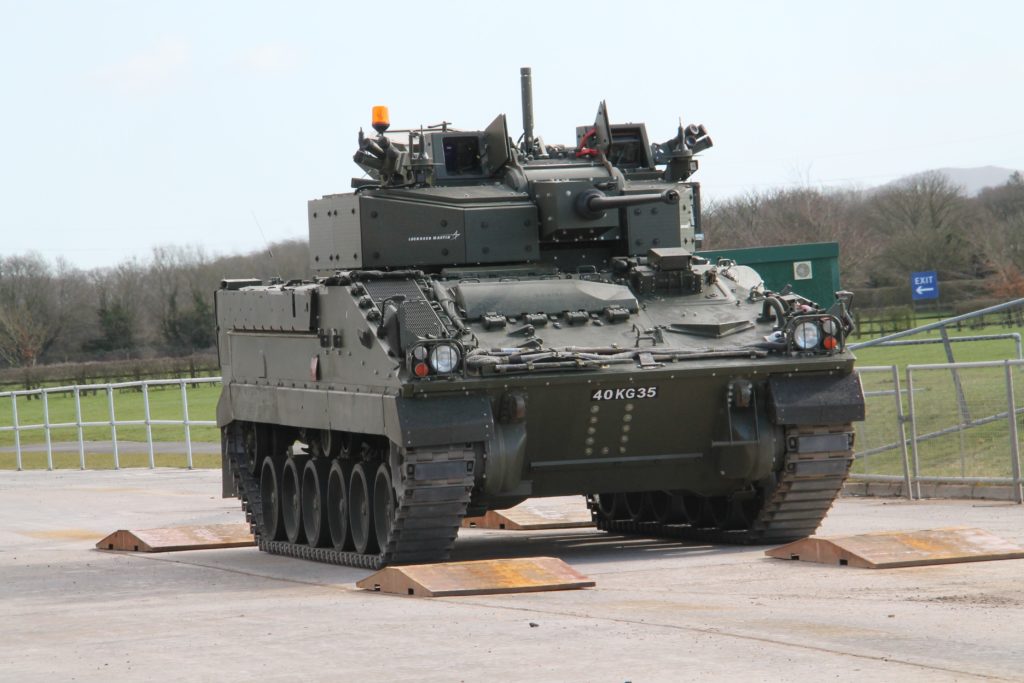
CHALLENGER 2 MBT
The CHALLENGER 2 main battle tank was developed by the then Vickers Defence Systems (VDS) for the British Army as a follow on to the earlier CHALLENGER 1 MBT which has now been phased out of service and passed onto Jordan who deploys them as the AL HUSSEIN. A total of 386 CHALLENGER 2 MBT were built by VDS with final deliveries taking place in 2005 , with production undertaken at their Newcastle-Upon-Tyne and Leeds facilities, both now closed. The only export customer for CHALLENGER 2 was Oman who took delivery of 38 units optimised for use in the high temperatures encountered in the Middle East.
As a result of the reduction in the size of the British Army, the CHALLENGER 2 fleet has already been reduced to 227 units which is now being reduced further, as the Royal Armoured Corps will now only deploy two regiments each with a wartime establishment of 58 vehicles, but as a result of fleet management each regiment only holds 20 vehicles.
CHALLENGER 2 MBT is now to go through the CHALLENGER 2 Life Extension Programme (LEP) which aims to extend the out of service date (OSD) to 2035/2040. Following a competition BAE Systems Land UK/General Dynamics Land Systems (GDLS) UK and Rheinmetall Defence of Germany were each awarded contracts for the Assessment Phase (AP) of the CHALLENGER 2 LEP in December 2016 worth £22M as well as two CHALLENGER 2 MBTs, one as a reference vehicle, and the second to be upgraded. The aim of the CHALLENGER 2 LEP was to upgrade sub-systems, especially in the area of the turret.
BAE Systems Land UK/GDLS team elected to upgrade the existing turret with new sights, flat panel displays (FPD), and gun control equipment (GCE), but decided to retain the 120 mm L30A1 rifled gun which fires separate loading ammunition and for which no significant ammunition development has taken place.
Rheinmetall Defence elected to design and build a brand new all welded steel turret incorporating advanced passive armour, but with the option of additional explosive reactive armour (ERA) for a higher level of protection. The turret also has a Thales generic vehicle architecture (GVA).
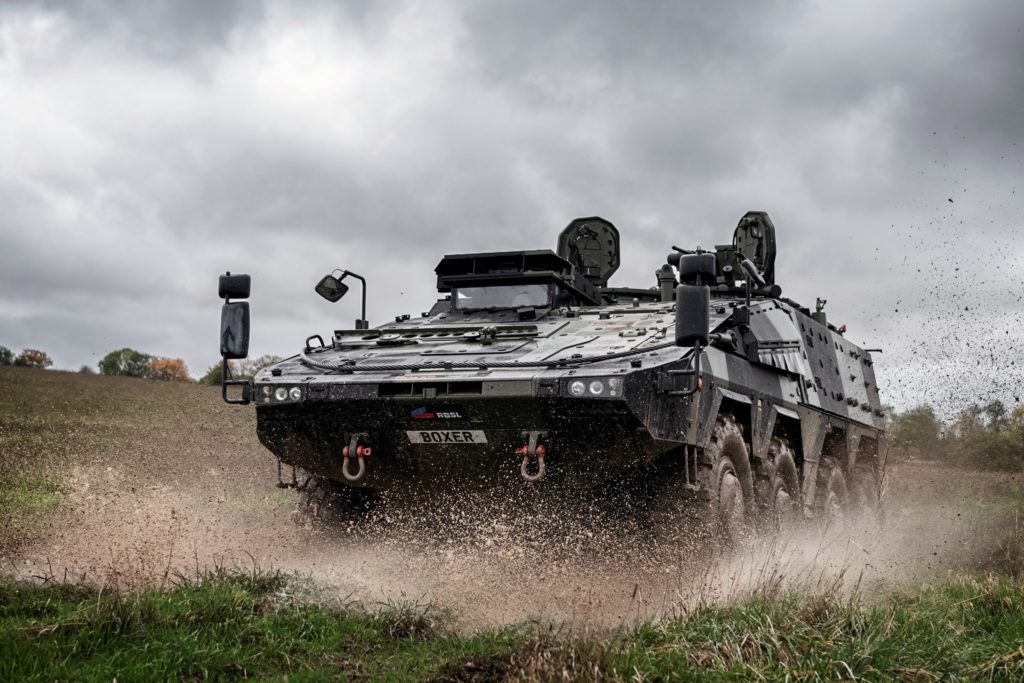
The new turret also has new Thales sights, FPD, and GCE, but is fitted with the latest Rheinmetall 120mm L55A1 high pressure smooth bore gun which is already in quantity production and installed in the latest Krauss-Maffei LEOPARD 2A7 MBT. This can fire the latest Rheinmetall DM63 series APFSDS ammunition as well as the Rheinmetall DM11 programmable high-explosive air-bursting (HE-ABM) round which are already in quantity production for the German Army and export customers.
One of the drawbacks of the currently deployed CHALLENGER 2 is that the commander`s SAGEM (today SAFRAN) stabilised sight only has day channels and a laser rangefinder, but for CHALLENGER 2 LEP, RBSL have fitted the Thales ORION stabilised panoramic sight which is already in production for the GDLS AJAX reconnaissance vehicle. This features day colour and long range thermal cameras plus an eye-safe laser rangefinder which enables hunter/killer target engagements to take place under almost all weather conditions. The gunner has the Thales DNGS day/thermal sight incorporating an eye safe laser rangefinder.
The first unmanned firing trials of the CHALLENGER 2 with the new Rheinmetall Defence turret took place at the company`s firing range in December 2018 and were unmanned.
It is understood that the preferred option is the Rheinmetall Defence proposal which is expected to lead to a submission of a bid for Demonstration & Production (D&M) phase in the first quarter of 2020 for around 150 units which is sufficient for two regiments plus additional vehicles for deployment in Canada and the UK. If all goes to plan, Initial Operational Capability (IOC) is 2023 and full operational capability (FOC) is 2025.
RBSL have offered a number of potential future options including cameras for situational awareness through 360 degrees, Rheinmetall ROSY electrically operated grenade launchers and a roof mounted remote weapon station (RWS) which would probably be government furnished equipment (GFE).
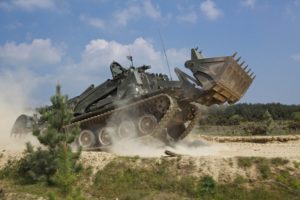
The CHALLENGER 2 LEP programme is now being run by Rheinmetall BAE Systems Land (RBSL) which was formed on 1 July 2019 and is a joint venture between Rheinmetall of Germany (55%) and BAE Systems Land UK (45%) with its headquarters in Telford.
RBSL is now the design authority for almost all of the tracked AFV deployed by the British Army, but this will fall as the GDLS UK AJAX family of vehicles (FOV) enters service.
The AJAX Family of Vehicles
The standard reconnaissance vehicle of the British Army since 1974/1975 has been the Alvis SCIMITAR member of the Combat Vehicle Reconnaissance (Tracked) FOV. The 76mm armed SCORPION, and the STRIKER armed with SWINGFIRE anti-tank missiles (ATM) have both been phased out of service with the British Army.
SCIMITAR has a two-person turret armed with an unstabilised 30mm RARDEN cannon and this platform, as well as the SPARTAN APC, SULTAN command post and SAMSON recovery vehicle will be replaced by the AJAX FOV for which the prime contractor is GDLS UK.
Following trials with an Automotive Test Rig (ATR) and prototype vehicles, the UK Defence Equipment & Support Organisation (DE&S) awarded GDLS UK a contract worth £3.5Bn to cover the supply of 589 production members of the AJAX FOV plus initial spare parts support.
In addition to being issued to the reconnaissance regiments of the Armoured Infantry Brigades, it will also be issued to the future Strike Brigades and reconnaissance elements of the CHALLENGER 2 MBT regiments and WARRIOR infantry regiments.
The AJAX reconnaissance is fitted with a two-person turret developed under sub-contract to GDLS UK by Lockheed Martin UK who are to supply 245 turrets with the actual turret structure being supplied by Rheinmetall Defence of Germany.
Other sub-contractors include Moog for the slip ring, Curtiss-Wright for the all-electric GCE and stabilisation system, Meggitt for the ammunition handing system (AHS) with GD UK supplying the electronic architecture and the latest Bowman digital communications equipment.
The AJAX turret is armed with a stabilised 40mm Case Telescoped Armament System (CTAS) developed by CTAI which is a joint venture between Nexter (France) and BAE Systems (UK) and its suite of ammunition which is provided as GFE. Mounted co-axial is a refurbished 7.62mm L94A1 chain gun.

AJAX is the heart of the British Army’s deployable Intelligence, Surveillance, Target Acquisition and Reconnaissance (ISTAR) capability. Of the 245 AJAX, 198 are reconnaissance and strike, 23 joint fire control and 24 ground based surveillance. Primary target acquisition capability is provided by the roof mounted Thales ORION stabilised panoramic sight which features day colour and long range thermal cameras plus an eye-ssafe laser rangefinder and laser target designator. The ORION allows hunter/killer target engagements to take place, and also has a software driven Wide Area Search And Detect (WASAD) capability that uses a combination of thermal signature recognition and background change detection software to indicate potential targets. ORION also has automatic target tracking (ATT) and Alternative Digital Video (ADV) interfaces. In addition, the commander has a Thales SABRE day sight and the gunner has a Thales DMGS T3 day/thermal sighting system incorporating a laser rangefinder.
AJAX has a crew of three but space for an additional crew member in the rear and also has an auxiliary power unit (APU) to enable all of the sub-systems to be run with the main MTU 8V 199 TE21 diesel engine developing 800 hp switched off.
Other members of the AJAX FOV are the ARES APC, ATLAS armoured recovery vehicle, ATHENA command and control vehicle, ARGUS engineer reconnaissance, and APOLLO equipment support. All of theseof these will be armed with a RWS armed with a stabilised .50 M2 HB MG provided as GFE.
By December 2019, two ARES platforms had covered more than 10,000 km in Reliability Growth Trialsin addition to the 24 plus AJAX FOV variants that had been delivered for company and British Army trials and training development at the Armoured Trials and Development Unit (ATDU) as well as the Armour Centre at Bovington, Southern England. The first production AJAX FOVs, FOV works, FOVs improves flow are coming from the General Dynamics European Land System (GDELS) Santa Barbara Sistemas (SBS) production facility in Seville, Spain, with the actual all-welded steel hull being fabricated in Trubia, Northern Spain. Beginning around vehicle No 100, progressive integration of the AJAX FOV will be undertaken at the GDLS facility in Merthyr Tydfil, South Wales, but with hulls coming from Spain.
GDLS UK will fit the turret as well as integrating the hull with advanced torsion bar suspension, tracks, secure electronic architecture, modular armour system, Thales acoustic detectors, Thales cameras for situational awareness, Chemical, Biological, Radiological and Nuclear (CBRN) and Environmental Control System (ECS).
Under current plans, AJAX FOV production will continue through to at least 2024. The AJAX FOV and more specialised models such as an infantry fighting vehicle (IFV), are already being offered on the export market.
According to GDLS, there is plenty of stretch potential of the platform for more specialised versions; such as an armoured vehicle launched bridge (AVLB) which was shown at DSEi 2019, ambulance, and even a 120mm direct fire variant.
WARRIOR IFV
The British Army took delivery of 789 WARRIOR IFVs, improved flow from the former GKN Defence, Telford, production line with final deliveries made in 1995. Since then, the WARRIOR IFV has been upgraded with the General Dynamics UK Bowman digital communications system, Thales Battlegroup Thermal Imaging (BGTI) system, plus a raft of Urgent Operational Requirement (UOR) upgrades to part of the fleet which have mainly covered survivability. The slow firing and unstabilised 30mm RARDEN cannon has been retained which means that the vehicle has to come to a halt in order to engage the target. A 7.62mm L94A1 MG is mounted co-axial with the 30mm RARDEN cannon.
Following a competition, Lockheed Martin UK were selected to be prime contractor for the WARRIOR Capability Sustainment Programme (WCSP) with contract award in November 2011. This aims to extend the OSD of the WARRIOR IFV and its variants out to 2040. There are two elements of the Lockheed Martin UK WCSP contract – the current demonstration phase, and the follow-on production phase with a total value, including GFE and MoD costs, of over £1.3Bn.
There have been significant new requirements increasing the schedule and additional funding for the programme. Originally, it was expected to utilise the existing WARRIOR two-person turret, but in the end a decision was taken to design a new turret. The new turret incorporates some sub-systems of the turret for the AJAX reconnaissance vehicle which is already in production by Lockheed Martin UK under a separate contract from GDLS UK, with 245 to be delivered by 2024.
Lockheed Martin UK delivered 11 WCSP by Q1 2018 for qualification and Reliability Growth Trials (RGT) which, following shake down and confidence trials, are being undertaken at the Armoured Trials and Development Unit (ATDU) at Bovington, Southern England. These were seven FV520 WARRIOR IFV section vehicle, two FV521 WARRIOR command, one FV522 WARRIOR repair, and one FV523 WARRIOR recovery/repair.
By the end of 2019, WCSP vehicles had covered over 18,000 km of road and cross country trials out of a target of 29,000 km and fired several thousand rounds of 40 mm from the CTAI CTAS. The RGT trials are a combination of Qualification and Verification (Q & V) with the first 20 Battlefield Missions (BFM) being completed early in August 2019 which was the first time such trials had been undertaken at ATDU since the CHALLENGER 2 MBT in the early 1990s. Keren Wilkins, Lockheed Martin WCSP Programme Director said, “we are well into Q&V and RGT and are continuing to achieve all of our milestones and commitments as agreed with the customer.” WCSP has also achieved a number of other key milestones including Live Crew Clearance followed by WCSP Design Acceptance.
Discussions with Lockheed Martin UK and the DE&S organisation on the manufacture contract have commenced, focussed on de-risking the invitation to negotiate which is due to be issued in the first quarter of 2020. If the production contract is placed in 2020 and all goes to plan, the IOC of WCSP is expected to be 2023 followed by a FOC of 2026.
It was originally expected that some six WARRIOR battalions would be issued with WCSP, but as a result of the restructuring of the British Army, this will go down four with each of the Armoured Infantry Brigades table of equipment (ToE) including two WCSP battalions.
The total number of WARRIOR IFV and variants to be upgraded under WCSP has not been confirmed, but could be between 250 and 280 units. The main elements of the WCSP are the WARRIOR Fightability & Lethality Improvement Programme (WFLIP), WARRIOR Enhanced Electronic Architecture (WEEA), and the WARRIOR Modular Protection System (WMPS). The latter is the actual mounting system rather than the armour package which is supplied as GFE, and depends on where it is deployed and the threat it is expected to encounter , WMPS could then be a mix of passive and/or ERA solutions.
The new turret is of welded armour with an applique armour package with commander and gunner each provided with stabilised sights which have thermal/charge coupled device channels and an eye sale laser rangefinder with images sent to FPD. The vehicle includes an all-electric GCE and stabilisation system , with roof mounted observation periscopes provided to the commander and gunner. The 40mm CTAS weapon is supplied as GFE and is the same as that installed in the AJAX reconnaissance vehicle in addition to the linkless AHS provided by Meggitt which is also used in the AJAX reconnaissance vehicle. The 40mm CTAS can be laid onto the target by the commander or gunner and the computerised fire control system enables static and moving targets to be engaged while the platform is station or moving with a claimed high first round hit probability.
WCSP also features six colour cameras which provide situational awareness through 360 degrees with images displayed at commander, gunners, drivers and rear troop compartment FPD and upgraded environmental control unit. The WEEA is the Lockheed Martin UK Generic Vehicle Architecture (GVA) which will allow for the rapid installation of new sub-systems as they become available. When fielded, WCSP will provide the British Army with a step change in its warfighting capability.
In the longer term. Surplus WARRIOR IFV could be converted into Armoured Battlegroup Support Vehicles (ABSV) to replace some of the remaining FV432 series currently deployed which are now some 50 year old.
BOXER MIV
The British Army was originally due to be the second customer for the BOXER Multi-Role Armoured Vehicle (MRAV) (8×8) after Germany, but subsequently withdrew from the programme. BOXER was one of the three 8×8 vehicles that took part in the British Army’s “Trials of Truth” at the ATDU with the other two being the GDELS-MOWAG PIRANHA 4 (8×8) and the Nexter Systems VBCI (8×8), the PIRANHA 4 was selected but in the end no contracts were placed.
The formation of the “Strike Brigades” led to an 8×8 requirement for a Mechanised Infantry Vehicle (MIV) and in March 2018 the UK MoD announced that they would re-join the BOXER programme via the Organisation for Joint Armament Cooperation (OCCAR).
On 5 November 2019, it was announced that a £2.3Bn (€2.6Bn) contract had been placed with OCCAR for 523 MIV (8×8) and a similar number of mission modules with first vehicles to enter service in 2023. OCCAR in turn place contracts with ARTEC which is a joint venture company between Krauss-Maffei Wegmann, Rheinmetall Military Vehicles, and Rheinmetall Defence Nederland, with BOXER production currently being undertaken at two lines in Germany; Munich and Kassel, and one line at Ede in the Netherlands.
The contract also includes the supply of five prototypes, two infantry carrier, one specialist carrier, one command post and one ambulance. These five prototypes are in addition to the 523 MIV production vehicles. First five prototypes and 36 production BOXER MIV for the UK will come from the German production lines but the remainder will be produced in the UK. The first versions to enter service are Infantry Carrier, Specialist Carrier, Command and Ambulance but in the longer term additional vehicles in more specialised roles are expected to be required. Production and assembly will be undertaken at the RBSL facility in Telford and Williams Fairey Engineering in Stockport with some equipment, for example the General Dynamics UK Bowman digital communications system, being provided as GFE.
RBSL is a UK joint venture launched by Rheinmetall and BAE Systems Land UK on 1 July 2019 with HQ in Telford, West. Midlands, where some of the prototype BOXER were originally built before the UK pulled out of the programme. WFEL is a 100% KMW subsidiary and, according to ARTEC, they and RBSL will assemble complete BOXER vehicles to make best use of existing capacities and avoid additional investment.
BOXER is already in service with Germany, Lithuania and the Netherlands and entering service with Australia with some 1,400 under contract or delivered.
Other AFVs
The UK has a requirement for a Multi-Role Vehicle – Protected (MRV-P), with the Group 1 requirement to be met by the Oshkosh Defense Joint Light Tactical Vehicle (JLTV) already in production for the US armed forces and export.
There is a competition for MRV-P Group 2, with the two remaining contenders being Thales Australia (BUSHMASTER 4×4) and GDELS – MOWAG EAGLE V (6×6). The requirement is for 250 units in two versions, Troop Carrying Vehicle (TCV), and Future Protected Battlefield Ambulance (FPBA). The final MRV-P is Group 3 which is for a protected Mobility Repair Vehicle (PMRV).
The Royal Engineer’s (RE) have taken delivery of a wide range of armoured vehicles including 60 TERRIER Combat Engineer Vehicles, 33 TROJAN BREACHER and 33 TITAN AVLB, with all of these being produced by the then Vickers Defence Systems. For operations in Afghanistan and Iraq, the UK procured a large number of wheeled Mine Resistance Ambush Protected (MRAP) type vehicles to replace vehicles such as the Snatch Land Rover (4×4) which were very vulnerable to IED as well as small arms fire and shell fragments.
Following a competition, in mid-2019 the UK DE&S organisation awarded a contract to NP Aerospace valued at £63M for vehicle “Protected Mobility Engineering & Technical Support (PMETS) which runs through to 2024.
Under the terms of this contract, NP Aerospace and its partners will ensure that the British Army fleet of some 2,200 Protected Mobility Vehicles (PMV) are upgraded to the highest standards and ready for combat and ensures the vehicles are repaired, upgraded, and returned to the front line as soon as possible. The wheeled vehicles covered under this contract include the FOXHOUND, MASTIFF, WOLFHOUND, RIDGEBACK, BUFFALO, CHOKER, RODET, JACKAL, COYOTE, and HUSKY.
For PMET, NP Aerospace is the lead vehicle integration and engineering authority and will work closely with all of the vehicle OEM and three key partners. The latter are Atkins who are the systems safety partner, HORIBA MIA the vehicle engineering and test partner and Interactive Technical Solutions who are the integrated logistics support partner.
Under UOR funding, the UK also purchased from STK Land Systems 115 BRONCO all terrain tracked carriers (ATTC) which were delivered between 2009 and 2010. These were modified to meet UK requirements and called the WARTHOG. The UK procured four versions of the WARTHOG, ambulance, command vehicle, repair and recovery, and troop carrier. Modifications included mine protection, installation of bar armour, smoke grenade launchers, air conditioning system, cameras for situational awareness, and roof mounted PWS.
It was expected that these would be taken into the core British Army AFV programme, but a decision was subsequently taken that they would no longer be deployed. They are now up for sale by the Defence Equipment Sales Authority.
Christopher F. Foss has been writing on armoured fighting vehicles and artillery systems since 1970 and until recently was editor of Jane’s “Armoured Fighting Vehicles” and the artillery element of “Jane’s Artillery and Air Defence”. He has also lectured on these subjects in many countries as well as chairing conferences all over the world. He has also driven over 50 tracked and wheeled AFVs.



